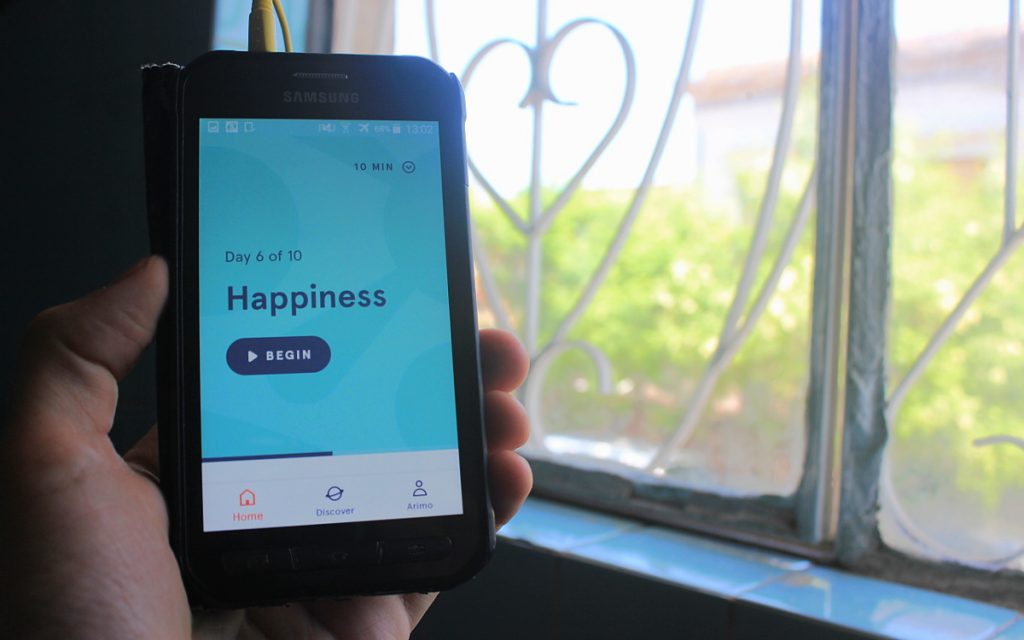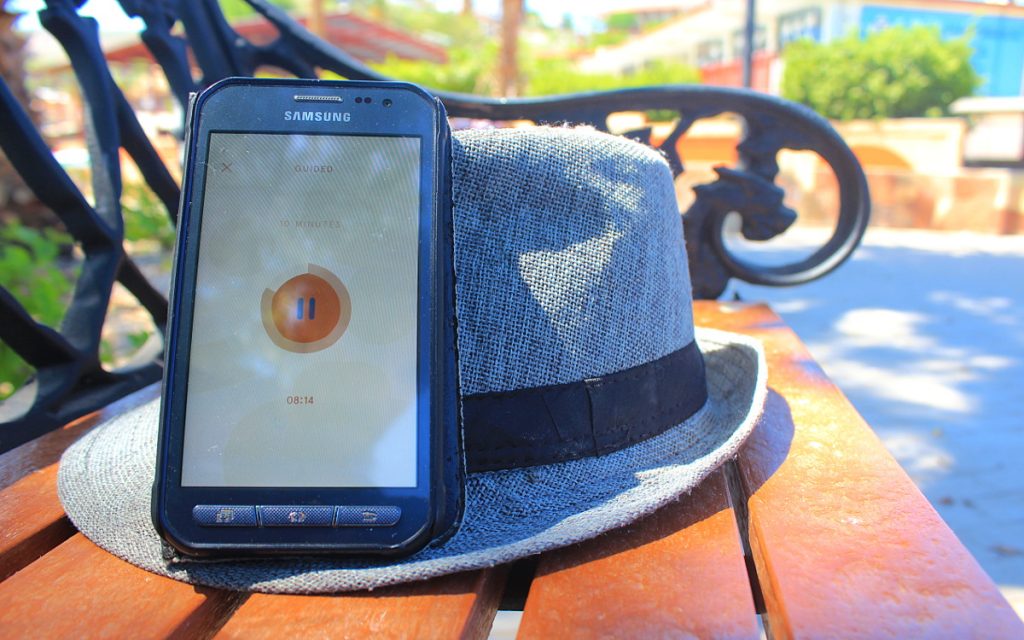Headspace is a guided meditation app that offers short meditation exercises for daily use. In this Headspace app review, I share my Headspace experiences after using the app for a year.
Mindfulness and meditation are getting a lot of buzz these days. Science has proven several health benefits of regular meditation. and the idea of mindfulness (focusing one’s attention on the present moment) is spreading far and wide.
With millions of users, Headspace is one of the front-runners in this development. Originally released in 2011, the Headspace meditation app offers guided meditation and mindfulness training on your phone. Normal Headspace meditation sessions last 10, 15 or 20 minutes, although the app also offers a few longer and shorter exercises.
The first 10 days (or 30 if you search “headspace 30 day trial” on Google) of Headspace are free. After that, the app costs almost 100 dollars (or around 75 $ if you use a discount voucher) for a 12-month subscription.
Is a Headspace subscription worth it? This in-depth Headspace app review sums up what I think.

The Headspace app got a new interface this year.
Headspace Review: My Experience
As you may have noticed, this website is my travel blog. What is a Headspace app review doing on a travel blog, you ask?
Well, my Headspace journey is very much connected to my less-metaphorical journey around the world. I’ve studied psychology and practiced mindfulness before, but I only started meditating daily during the first year of my trip around the world. As I constantly move from place to place, meditation has worked like an anchor that keeps me grounded despite the changing environments.
Headspace is not the only meditation platform that I’ve been using. Before choosing Headspace, I finished a trial of Calm, another popular mindfulness app. I also completed the 8-week mindfulness-based stress reduction (MBSR) program from Jon Kabat-Zinn‘s book “Full Catastrophe Living“.
In February 2017 I even spent 10 days on a silent Vipassana meditation retreat!
I’ve also read other books and practiced other programs based on mindfulness. However, Headspace remains the one meditation platform that I’ve been using the most. As I write this Headspace review, I’ve been practicing with the Headspace app for almost a year.
Starting Your Headspace Experience
It’s remarkable how easy it is to get started with your Headspace experience. The co-founder and public face of Headspace, Andy Puddicombe, explains the basics of Headspace meditation on the first basic courses. Puddicombe has a very friendly and clear voice, making his instructions easy to follow. Even if you haven’t done any meditation before, Headspace makes it very easy to learn the basics.
The Headspace app offers two types of guided meditation exercises: singles and packs. Singles are individual exercises that can be done at any point. Packs are theme-specific courses that last either 10 or 30 days. For example, a 30-day Sleep pack consists of daily meditation sessions that change during the course as well as tasks and lessons that are given before and after the meditation.
The Headspace app is very effortless to use, and there’s nothing extra to disturb your concentration. The interface is sleek and mostly intuitive. Headspace also features colorful and entertaining animations that explain some theories and ideas behind mindfulness. The presentation is beautiful and works very well.

I don’t know how to caption this photo, so I’ll just mention “Headspace review” here so people who search for Headspace app reviews will find my review on Google.
What Kind of Meditation is Headspace?
There are tons of different ways to do meditation. So, what kind of meditation does Headspace offer?
The co-founder of Headspace, Andy Puddicombe, is a former Buddhist monk, but he follows a secular path with Headspace. There’s no chanting or mantras involved, just simple focusing on the present moment. The philosophy and science behind different meditation exercises are occasionally explained, but the main focus is on the practice, not the theory.
The techniques of Headspace depend on the pack. Most exercises focus on following your breathing and noting different thoughts and sensations. Some packs also include methods like visualization, and you do a short body scan at the beginning of each exercise. If you’ve done mindfulness based meditation before, you’ve probably done at least a few of these techniques.
There are two features that make Headspace meditation different from many other forms of meditation. First of all, the exercises are relatively short, only 10-20 minutes depending on your choice. The meditation packs and singles also revolve around very specific themes such as anxiety, relationships and pregnancy.
The Pros and Cons of Headspace Meditation
Headspace’s time-saving and focused approach has its good and bad sides. On the positive side, the quick meditation sessions are very easy to fit on your schedule. Choosing themes that you really care about really helps you stay motivated. On the other hand, the execution of these features is not flawless.
It’s great to be able to choose the length of your Headspace guided meditation sessions. Still, I was initially a bit disappointed that the longer exercises are just the same recording with longer gaps between instructions. I occasionally feel like the pacing of the exercise works best on the shortest version.
The wide variety of themed packs can also be somewhat misleading. There’s a lot of overlapping between many of the courses. In a way, the familiarities make sense – Headspace and mindfulness teach a particular approach in life, so it’s natural that different packs repeat the same teachings. Still, it can be slightly disappointing at first.
Mindfulness is a philosophy that tells you not to crave too much for the things you desire. For example, the sleep pack of Headspace aims not to teach you how to sleep better, but to help you stop worrying about your insomnia and sleep problems. Better sleep may then come as a side effect when you stop trying too hard.
The less goal-oriented approach might also surprise new users, but it actually works.

You know, it’s very hard to fit the words “Headspace app review” inside a Headspace app review.
Review of the New Headspace Experience
The Headspace guided meditation app gets a few updates each year. Usually this means new packs – for example, a 30-day Pain Management pack was released in April 2017. However, in July 2017, Headspace released the New Headspace app – a complete makeover of the old Headspace app.
The New Headspace experience came with a graphic re-design, new interface and several new packs. The New Headspace also added Minis, short meditation sessions that last only 1-3 minutes. New Headspace features include a chance to do several packs simultaneously. You can also change the length of your meditation sessions at any point of a pack.
The New Headspace app is clearly an improvement, but it also makes a few sacrifices. The old app featured recorded videos of Headspace co-founder Andy Puddicombe, but those clips are now gone. The video lessons made feel like I had a personal connection with my instructor, so I miss them a bit.
The new Headspace app has more animations and new text-based instructions, but they don’t completely replace the video clips.
Problems of the New Headspace app
The removal of videos is a matter of preference, but the new Headspace app also has some bigger annoyances that I hope will get fixed in the future. These issues won’t disturb all users, but they make using Headspace while travelling a bit more difficult.
During the upgrade, Headspace made its download management system worse than before. In the new Headspace app, you can no longer freely micromanage the downloads. You can now choose to download a whole pack for offline use, but you can’t download or remove individual sessions.
My Android phone has a small internal memory (that’s already full of travel-related apps), so I’m constantly struggling with space restrictions. It’s not possible to move the Android version of Headspace app to a memory card, so the new app has made my storage management way harder than before.
This is not the only problem with offline use. Even worse, you can no longer proceed to the next session of a pack unless you go online in between. When I was preparing for a 16-day cargo ship voyage across the Pacific, I had to open and skip through sixteen sessions to be able to follow the pack during my freighter trip!
Most Headspace users have a constant and fast internet access, so these things won’t be an issue for the majority of people. But if you’re using Headspace while traveling, the new difficulties can be rather annoying.

How should I caption this… Did I already use the words “Headspace app review” too many times?
Does Headspace Really Work?
Of course, minor technical details are not that important. The most important question of this Headspace app review is this: Does Headspace really work?
I can’t give a definite answer, but I believe it does. As I mentioned in the beginning of my Headspace review, meditation has scientifically proven benefits. Headspace teaches proper mindfulness and meditation techniques in an easily approachable way. After a meditation session, I often better than I did before it. I’ve also been apple to apply the techniques and instructions to my daily life.
At the same time, one can question if Headspace goes far enough with its mindfulness teaching. Although the Headspace packs give some simple tasks for your daily life, the meditation app very rarely asks you to consider your life choices or daily habits. In this sense, I prefer a Finnish-only meditation app called Oiva which really makes its users think about their values.
Is Headspace Subscription Worth It?
The free trial of Headspace only shows you the basics of the meditation technique. To get a full Headspace experience, you need to pay for a Headspace subscription. So I’ll finish my Headspace review with one final question: is a Headspace subscription worth it?
If you can afford the rather high subscription fee, I’d say you get enough content for your payment – at least for a while. Headspace adds new packs regularly, but many of them have been targeted to to more specific audiences such as athletes, students and cancer patients. I’ve been using Headspace for almost a year now, and I’m now finding it a bit harder to find new packs that really speak to me.
Still, you can always return to the meditation packs that you’ve previously completed. After all, most mindfulness meditation programs give you just a few basic programs that you repeat for a lifetime. It remains to be seen if Headspace can keep its users hooked for years to come.
For now though, Headspace offers a sleek and well-presented platform for basic meditation. Whether you’re an experienced meditator or a complete novice, the app can give you clear benefits and helps you keep up with your daily meditation practice.
UPDATE: I’ve now also read the Headspace companion book “The Headspace Guide to Meditation and Mindfulness” by Andy Puddicombe. If you’re interested, you can check my Headspace book review here.










9 comments
Great Review on the headspace app! Do you know of a similar app like Oiva, that is in English.
Thank you Adam! 🙂 No, unfortunately I don’t!
Thanks for the well thought-out review man 🙂 I’m about to start using the app and am hoping it’ll help with study stress I’m feeling at the moment. Enjoy your travels…epic!!
Thank you James! 🙂 I’ve found the app helpful with stress. Enjoy your meditation!
Thank you for this review. I purchased the subscription and I’m now on day 25. I feel it’s working. Keeping me in the “present”. I feel more relaxed and I don’t get stressed out as easily. I’m looking forward to getting to the other packs like anxiety and pain management.
I’m brand new to meditation. Didn’t know where or how to begin and this app has made it so easy.
You’re welcome! 🙂 The Headspace app is definitely a great way for beginners to start meditating.
Hey there Arimo!
Thank you for this review! I just finished the 10-day-trial sessions and i felt like it already helped me. The only problem was, i wasn’t sure whether it is worth it to spend 90€ on this app for a year, but after your review I feel positive that it will be worth it!
Thank you so much and enjoy your travels, that’s awesome! I backpacked through New Zealand for a year and i really start to miss it when I read your interesting blog-posts!
Have a great time!
Greetings,
Michael
Thank you Michael for your comment and feedback, it really put a smile on my face! 🙂 Enjoy your meditation!
I do not like that you are linked to Facebook and Spotify and the dact you do not say up front that there is a fee involved. I think deceptive on your part.